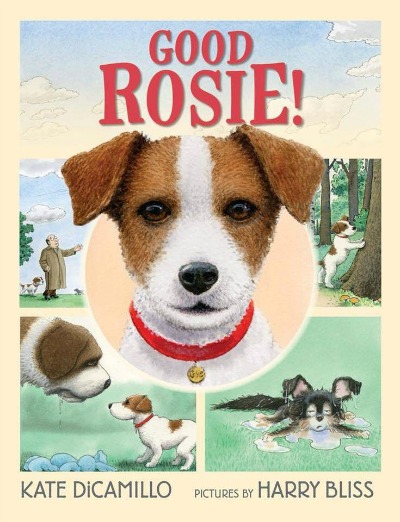
A quiet dog living a quiet life with a loving owner begins to realize her loneliness in the new picture book Good Rosie written by Kate DiCamillo and illustrated by Harry Bliss. This simple life seems to be just right for her owner George, but he senses Rosie might benefit from a little something more. And because she’s such a good dog, he wants her to be happy.
George observes Rosie’s apparent loneliness and thinks it would be great for her to be around some other dogs, so off to the dog park they go. Unfortunately, Rosie feels a bit shy and overwhelmed at the number of other dogs there, and she doesn’t quite know what to do or how to fit in. When she’s approached by two other dogs, each at one extreme of size when it comes to canines, she simply wants to go home. It’s easy to see that while Rosie wants friends, she isn’t sure how to make them, and her lack of experience makes her long for the comfort of home. But when faced with a tricky situation involving these two dogs, Rosie acts quickly and without thinking about it too much, she saves the day. In the end, the three dogs teach each other a few things about friendship.
Told in the style of cartoon panels– illustrator Harry Bliss’s natural medium as a cartoonist– this picture book works as a lovely introduction to graphic novels for young readers. Broken into nine parts, the story is told in different scenes with text and some dialogue, and young readers will begin to see how a graphic novel’s format is different than a traditional picture book. Kate DiCamillo is a master at conveying emotion through her text, and Rosie’s uncertainty and longing is palpable and absolutely relatable here. Harry Bliss creates lovable characters in his drawings, and his attention to detail gives a sophisticated feel to this book.
I had the great fortune of seeing Harry Bliss and Kate DiCamillo speak at the Library of Congress’ National Book Festival in Washington, DC, over the first weekend in September. Their personal senses of humor and affability came through immediately, and they shared a bit of the book with the large audience, which was a treat. Each is a true lover of dogs, and my favorite laugh from their speech came when DiCamillo asked the audience how many of us had dogs. When lots of hands went up and cheers were audible, she said something enthusiastic about how dogs are wonderful. Then she asked how many of us had cats. After the crowd’s response (which, for the record, was smaller than to the first question), she replied with a simple murmur, “Okay.” Dogs ruled during this presentation, for sure!

